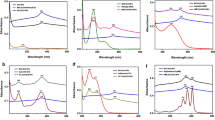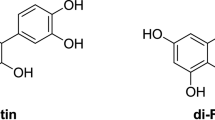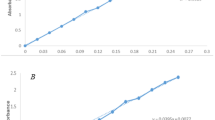Abstract
β-Lactum antibiotics are broad class of antibiotics which kills bacteria by inhibiting the formation of peptidoglycan that constitutes the bacterial cell wall. The resistance that develops in bacteria for antibiotics led the scientific world to think about the future aspects for modifying the way through which antibiotics are acted on the bacteria and become lethal for them. In this consequence, the potential of latest marketed antibiotics e.g. Amoxiciline (I), ceftazidim (II) have been evaluated after being conjugated with quantum dots. The surface of quantum dots has been conjugated with antibiotics by carbodiimide coupling with the help of 1-ethyl-3-(3-dimethylaminopropyl) carbodiimide (EDC) and N-hydroxysuccinimide (NHS) as conjugating agent between antibiotic and functionalized quantum dots. The antibacterial properties of QD-conjugated antibiotics have been determined by disc diffusion assay. The potency of QD-conjugated antibiotics has been estimated by determining their MIC50 for the selected strain of Gram-negative (Escherichia coli) and Gram-positive (Staphylococcus aureus) bacteria. Minimum inhibitory concentration study, minimum bactericidal concentration and growth pattern analysis revealed that QD-antibiotic conjugates showed slightly more prospective than pure native antibiotics against both Gram-negative (Escherichia coli) and Gram-positive (Staphylococcus aureus) bacteria.
Graphical Abstract











Similar content being viewed by others
Data Availability
All the data and materials from this manuscript will be made available on request.
References
Imming P, Klar B, Dix D (2000) Hydrolytic stability versus ring size in lactams: Implications for the development of lactam antibiotics and other serine protease inhibitors. J Med Chem 43:4328–4331
Taggi AE, Hafez AM, Wack H, Young B, Drury WJ, Lectka T (2000) Catalytic, asymmetric synthesis of β-lactams. J Am Chem Soc 122:7831–7832
Garrity JD, Bennett B, Crowder MW (2005) Direct evidence that the reaction intermediate of metallo-β-lactamase L1 is metal bound. Biochem 44:1078–87
Farina V, Hauck SI, Firestone RA (1996) Synthesis of cephems bearing olefinic sulfoxide side chains as potential β-lactamase inhibitors. Bioorg Med Chem Lett 6:1613–1618
Liu YC, Huang WK, Huang TS, Kunin CM (1999) Detection of antimicrobial activity in urine for epidemiologic studies of antibiotic use. J Clinical Epidem 52:539–545
Zhang HZ, Hackbarth CJ, Chansky KM, Chambers HF (2001) A proteolytic transmembrane signaling pathway and resistance to β-lactams in staphylococci. Science 291:1962–1965
Neu HC (1992) The crisis in antibiotic resistance. Science 257:1064–1073
Helena B, Andrea L, Sylvia J, Wolfgang MP, Janka K, Peter M, Milan K (1998) Study of β-lactam resistance in ceftazidime-resistant clinical isolates of Enterobacteriaceae. Int J Antimicrob Agents 10:135–141
Pitout JD, Sanders CC, Sanders WE Jr (1997) Antimicrobial resistance with focus on β-lactam resistance in gram-negative bacilli. Am J Med 103:51–59
Craig WA (1996) Antimicrobial resistance issues of the future. Diagn Microbiol Infect Dis 25:213–217
Miethke M, Pieroni M, Weber T, Brönstrup M, Hammann P, Halby L, Arimondo PB, Glaser P, Aigle B, Bode HB, Moreira R (2021) Towards the sustainable discovery and development of new antibiotics. Nature Reviews Chemistry 5:726–749
Souli M, Wennersten CB, Eliopoulos GM (1998) In vitro activity of BAY 12–8039, a new fluoroquinolone, against species representative of respiratory tract pathogens. Int J Antimicrob. Agents 10:23–30
Fonzé E, Vanhove M, Dive G, Sauvage E, Frere JM, Charlier P (2002) Crystal Structures of the Bacillus licheniformis BS3 Class A β-Lactamase and of the Acyl− Enzyme Adduct Formed with Cefoxitin. Biochemistry 41:1877–1885
Georg GI (1993) The Organic Chemistry of β-Lactamas (New York: VCH publishers) 121–96
Buynak JD, Doppalapudi VR, Adam G (2000) The synthesis and evaluation of 3-substituted-7-(alkylidene) cephalosporin sulfones as β-lactamase inhibitors. Bioorg Med Chem Lett 10:853–857
Jones RN, Marshall SA, Varnam DJ (1998) Activity of a broad-spectrum cephalosporin (Ro 48–8391) alone and in combination with two novel β-lactamase inhibitors (Ro 48–5545 and Ro 48–8724). Diagn Microbiol Infect Dis 32:85–89
Vergauwe A, Van Geldre E, Inzé D, Van Montagu M, Van den Eeckhout E (1996) The use of amoxicillin and ticarcillin in combination with a β-lactamase inhibitor as decontaminating agents in the Agrobacterium tumefaciens-mediated transformation of Artemisia annua L. J Biotechnology 52:89–95
Sondi I, Salopek-Sondi B (2004) Silver nanopartiklar som antimikrobiellt medel: en fallstudie på E. coli som modell för gramnegativa bakterier. J Colloid Interface Sci 275:177–182
Lyon DY, Adams LK, Falkner JC, Alvarez PJ (2006) Antibacterial activity of fullerene water suspensions: effects of preparation method and particle size. Environ Sci Tech 40:4360–4366
Lok CN, Ho CM, Chen R, He QY, Yu WY, Sun H, Che CM (2007) Silver nanoparticles: partial oxidation and antibacterial activities. J Biological Inorg. Chem. 12:527–534
Heinlaan M, Ivask A, Blinova I, Dubourguier HC, Kahru A (2008) Toxicity of nanosized and bulk ZnO, CuO and TiO2 to bacteria Vibrio fischeri and crustaceans Daphnia magna and Thamnocephalus platyurus. Chemosphere 71:1308–1316
Cao X, Li CM, Bao H, Bao Q, Dong H (2007) Fabrication of strongly fluorescent quantum dot− polymer composite in aqueous solution. Chem Mater 19:3773–3779
Li R, Li CM, Bao H, Bao Q, Lee VS (2007) Stationary current generated from photocycle of a hybrid bacteriorhodopsin/quantum dot bionanosystem. App Phys Lett 91:223901
Zhu C, Chen Z, Gao S, Goh BL, Samsudin IB, Lwe KW, Wu Y, Wu C, Su X (2019) Recent advances in non-toxic quantum dots and their biomedical applications. Progress in Natural Science: Mater Int 29:628–640
Constantine CA, Gattás-Asfura KM, Mello SV, Crespo G, Rastogi V, Cheng TC, DeFrank JJ, Leblanc RM (2003) Layer-by-layer biosensor assembly incorporating functionalized quantum dots. Langmuir. 19:9863–9867
Heger Z, Cernei N, Blazkova I, Kopel P, Masarik M, Zitka O, Adam V, Kizek R (2014) γ-Fe2O3 Nanoparticles Covered with Glutathione-Modified Quantum Dots as a Fluorescent Nanotransporter. Chromatographia 77:1415–1423
Voura EB, Jaiswal JK, Mattoussi H, Simon SM (2004) Tracking metastatic tumor cell extravasation with quantum dot nanocrystals and fluorescence emission-scanning microscopy. Nature Medicine 10:993–998
Alivisatos AP (1996) Perspectives on the Physical Chemistry of Semiconductor Nanocrystals. J. Phys. Chem. 100:13226–13239
Rhyner MN, Smith AM, Gao X, Mao H, Yang L, Nie S (2006) Quantum dots and multifunctional nanoparticles: new contrast agents for tumor imaging. Nanomedicine 1:209–217
Dwarakanath S, Bruno JG, Athmaram TN, Bali G, Vattem D, Rao P (2017) Antibody-quantum dot conjugates exhibit enhanced antibacterial effectvs. unconjugated quantum dots. Folia Microbiologica 52:31–34
Ananth DA, Rameshkumar A, Jeyadevi R, Jagadeeswari S, Nagarajan N, Renganathan R, Sivasudha T (2015) Antibacterial potential of rutin conjugated with thioglycolic acid capped cadmium telluride quantum dots (TGA-CdTe QDs). Spectrochim. Acta A: Molecul Biomol Spectro 138:684–692
Kloepfer JA, Mielke RE, Nadeau JL (2005) Uptake of CdSe and CdSe/ZnS quantum dots into bacteria via purine-dependent mechanisms. Appl Environ Microbiol 71:2548–2557
Allen PM, Bawendi MG (2008) Ternary I− III− VI quantum dots luminescent in the red to near-infrared. J Am Chem Soc 130:9240–9241
Blackman B, Battaglia D, Peng X (2008) Bright and water-soluble near IR-emitting CdSe/CdTe/ZnSe type-II/type-I nanocrystals, tuning the efficiency and stability by growth. Chem Mater 20:4847–4853
Jensen KF, Bawendi MG (1997) (CdSe)ZnS Core−Shell Quantum Dots: Synthesis and Characterization of a Size Series of Highly Luminescent Nanocrystallites. J. Phys. Chem. B 101:9463–9475
Du Y, Xu B, Fu T, Cai M, Li F, Zhang Y, Wang Q (2010) Near-infrared photoluminescent Ag2S quantum dots from a single source precursor. J Am Chem Soc 132:1470–1471
Hewa-Kasakarage NN, Gurusinghe NP, Zamkov M (2009) Blue-shifted emission in CdTe/ZnSe heterostructured nanocrystals. J Phys Chem C 113:4362–4368
Shen S, Zhang Y, Peng L, Du Y, Wang Q (2011) Matchstick-Shaped Ag2S–ZnS Heteronanostructures Preserving both UV/Blue and Near-Infrared Photoluminescence. Angew Chem Int Ed 50:7115–7118
Tsay JM, Pflughoefft M, Bentolila LA, Weiss S (2004) Hybrid approach to the synthesis of highly luminescent CdTe/ZnS and CdHgTe/ZnS nanocrystals. J Am Chem Soc 126:1926–1927
Zhang C, Ji X, Zhang Y, Zhou G, Ke X, Wang H, He Z (2013) One-pot synthesized aptamer-functionalized CdTe: Zn2+ quantum dots for tumor-targeted fluorescence imaging in vitro and in vivo. Anal Chem 85:5843–5849
Erogbogbo F, Yong KT, Roy I, Hu R, Law WC, Zhao W, Ding H, Wu F, Kumar R, Swihart MT, Prasad PN (2011) In vivo targeted cancer imaging, sentinel lymph node mapping and multi-channel imaging with biocompatible silicon nanocrystals. ACS Nano 5:413–423
Liu YF, Yu JS (2010) In situ synthesis of highly luminescent glutathione-capped CdTe/ZnS quantum dots with biocompatibility. J Colloid Interface Sci 351:1–9
Yu WW, Qu LH, Guo WZ, Peng XG (2003) Experimental determination of the extinction coefficient of CdTe, CdSe, and CdS nanocrystals. Chem. Mater 15:2854–2860
Bao H, Gong Y, Li Z, Gao M (2004) Enhancement effect of illumination on the photoluminescence of water-soluble CdTe nanocrystals: toward highly fluorescent CdTe/CdS core−shell structure. Chem Mater 16:3853–3859
He Y, Sai LM, Lu HT, Hu M, Lai WY, Fan QL, Wang LH, Huang W (2007) Microwave-assisted synthesis of water-dispersed CdTe nanocrystals with high luminescent efficiency and narrow size distribution. Chem Mater 19:359–365
He Y, Lu HT, Sai LM, Lai WY, Fan QL, Wang LH, Huang W (2006) Microwave-assisted growth and characterization of water-dispersed CdTe/CdS Core− Shell nanocrystals with high photoluminescence. J Phys Chem B 110:13370–13374
Dobrovolskaia MA, Clogston JD, Neun BW, Hall JB, Patri AK, McNeil SE (2008) Method for analysis of nanoparticle hemolytic properties in vitro. Nano Lett 8:2180–2187
Ostomel TA, Shi Q, Stoimenov PK, Stucky GD (2007) Metal oxide surface charge mediated hemostasis. Langmui 23:11233–11238
Liu YF, Yu JS (2010) In situ synthesis of highly luminescent glutathione-capped CdTe/ZnS quantum dots with biocompatibility. J Colloid Interface Sci 333:690–698
Trindade T, O’Brien P, Pickett NL (2001) Nanocrystalline semiconductors: synthesis, properties, and perspectives. Chem. Mater 13:3843–3858
Lu Z, Li CM, Bao H, Qiao Y, Toh Y, Yang X (2008) Mechanism of antimicrobial activity of CdTe quantum dots. Langmuir 24:5445–5452
Neelgund GM, Oki A, Luo Z (2012) Antimicrobial activity of CdS and Ag2S quantum dots immobilized on poly(amidoamine) grafted carbon nanotubes. Colloids Surf. B Biointerfaces 100:215–221
Luo Z, Wu Q, Zhang M, Li P, Ding Y (2011) Cooperative antimicrobial activity of CdTe quantum dots with Rocephin and fluorescence monitoring for Escherichia coli. J. Colloid Interface Sci. 362:100–106
Dhar R, Singh S, Kumar A (2015) Effect of capping agents on optical and antibacterial properties of cadmium selenide quantum dots. Bull. Mater. Sci. 38:1247–1252
Thakur M, Pandey S, Mewada A, Patil V, Khade M, Goshi E, Sharon M (2014) Antibiotic conjugated fluorescent carbon dots as a theranostic agent for controlled drug release, bioimaging, and enhanced antimicrobial activity. J. Drug Delivery 2014:1–9
Acknowledgment
We are thankful to sophisticated analytical instrument research facility (AIRF) Jawaharlal Lal Nehru University (JNU), New Delhi for TEM analysis. We are also grateful to Prof. M.K. Deb, School of Studies in Chemistry, Pt. Ravishankar Shukla University, Raipur for FTIR analysis. Authors are thankful to the head, School of Studies in Chemistry, Pt. Ravishankar Shukla University, Raipur for providing laboratory facilities. Authors are thankful to the head, School of Studies in Biotechnology, Pt. Ravishankar Shukla University, Raipur for providing laboratory facilities.
Funding
Financial assistance from DST-FIST and SAP is acknowledged with appreciation.
Author information
Authors and Affiliations
Contributions
S.K.V.: experiment, data interpretation and drafting of the manuscript; J.K.: some measurement of fluorescence; R.N.: correction and review of manuscript; T.V.: helped in performing the antibacterial activity experiment and interpretation; S.K.J.: supervise all the antibacterial activity experiment and interpretation; M.L.S.: supervise all the experiment, interpretation of data and manuscript writing.
Corresponding author
Ethics declarations
Ethical Approval
Not Applicable.
Consent to Participate
Not Applicable.
Consent for Publication
Not Applicable.
Conflict of Interests
The authors declare no competing interest.
Additional information
Publisher's Note
Springer Nature remains neutral with regard to jurisdictional claims in published maps and institutional affiliations.
Supplementary Information
Below is the link to the electronic supplementary material.
Rights and permissions
Springer Nature or its licensor (e.g. a society or other partner) holds exclusive rights to this article under a publishing agreement with the author(s) or other rightsholder(s); author self-archiving of the accepted manuscript version of this article is solely governed by the terms of such publishing agreement and applicable law.
About this article
Cite this article
Vaishanav, S.K., Korram, J., Verma, T.K. et al. Antibacterial Activity of CdTe/ZnS Quantum Dot-β Lactum Antibiotic Conjugates. J Fluoresc 34, 833–846 (2024). https://doi.org/10.1007/s10895-023-03316-x
Received:
Accepted:
Published:
Issue Date:
DOI: https://doi.org/10.1007/s10895-023-03316-x




